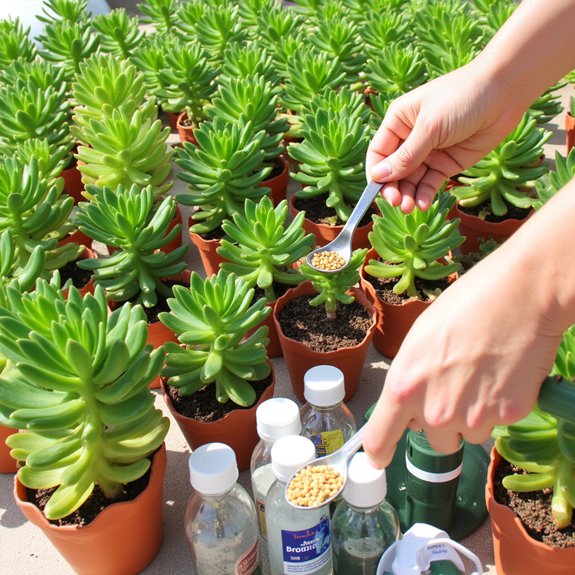Indoor gardening enthusiasts discover that succulents offer the perfect solution for transforming sterile spaces into vibrant, living environments. These hardy plants adapt to various light conditions, from bright south-facing windows to dimmer corners, making placement flexible throughout the home. Their striking geometric forms, waxy textures, and surprising color variations create instant visual interest. However, most people unknowingly commit critical mistakes during the first few weeks that can doom even the most resilient varieties.
Contents
- 1 Mastering Light Requirements for Thriving Succulents
- 2 Selecting the Perfect Containers for Your Plants
- 3 Creating Beautiful Arrangements With Multiple Species
- 4 Essential Watering Techniques to Prevent Root Rot
- 5 Smart Fertilizing Strategies for Healthy Growth
- 6 Preventing and Managing Common Pests and Diseases
- 7 Optimizing Temperature and Humidity Conditions
- 8 Maintenance Tips for Long-Term Succulent Success
Mastering Light Requirements for Thriving Succulents

While other houseplants may forgive dim corners and shadowy windowsills, succulents demand bright, consistent light to maintain their compact form and vibrant colors. Most species require a minimum of six hours of direct sunlight daily, making light duration absolutely critical for healthy growth. South-facing windows provide ideal light intensity, though some varieties like String of Pearls tolerate partial shade better than others.
When natural light falls short, grow lights become essential tools. These adjustable fixtures deliver the precise light intensity indoor succulents need, preventing the telltale stretching that signals insufficient illumination. Rotate plants weekly for even exposure.
Selecting the Perfect Containers for Your Plants
Although light sets the foundation for healthy succulents, choosing the right container determines whether plants will thrive or struggle with root rot. Container materials like terracotta offer superior breathability compared to plastic options, which trap moisture around sensitive roots. Drainage holes are absolutely essential, preventing water from pooling at the bottom.
Pot size requires careful consideration since oversized containers hold excess moisture for weeks. Choose containers slightly larger than the root ball, allowing room for growth without creating soggy conditions. Small pots dry quickly but require frequent repotting. Match container proportions to your specific succulent species for ideal health.
Creating Beautiful Arrangements With Multiple Species

Once container selection is complete, combining different succulent species transforms individual plants into enchanting indoor displays. Strategic color combinations create visual impact, pairing purple-hued Echeveria with silvery Dusty Miller or bright green Jade Plants. Texture contrasts elevate arrangements further, mixing smooth, rounded leaves with spiky, architectural forms.
Group plants with similar water and light requirements together for maintenance efficiency. Place taller species like Aloe toward the back, shorter varieties like String of Pearls cascading forward. Odd-numbered groupings of three or five plants typically look most natural and pleasing to the eye.
Essential Watering Techniques to Prevent Root Rot
After creating stunning visual displays with carefully grouped succulents, proper watering becomes the difference between thriving plants and disappointing failures. The “soak and dry” method works best for these desert dwellers. Water thoroughly until liquid drains from holes, then wait until soil moisture completely disappears before repeating.
Watering frequency depends on season and environment. During spring and summer, most succulents need water every 7-10 days. Winter dormancy requires less frequent watering, sometimes every 2-3 weeks. Always check soil moisture by inserting your finger two inches deep. Dry soil means it’s time to water again.
Smart Fertilizing Strategies for Healthy Growth

Unlike most houseplants that demand regular feeding schedules, succulents thrive on nutritional neglect. These desert natives evolved in nutrient-poor environments, making them surprisingly low-maintenance feeders. During active growth phases in spring and summer, apply a balanced, diluted fertilizer every two to three months. Choose fertilizer types specifically formulated for cacti and succulents, or dilute standard houseplant fertilizer to quarter strength. Avoid feeding during dormant winter months when growth naturally slows. Over-fertilizing causes rapid, weak growth that compromises plant structure and health, making succulents more susceptible to disease and pest issues.
Preventing and Managing Common Pests and Diseases
Several common pests target indoor succulents, but early detection and swift action prevent minor issues from becoming plant disasters. Mealybugs appear as white, cottony clusters on leaves and stems, while aphids create sticky honeydew residue. Scale insects look like small, brown bumps attached to plant surfaces.
Effective pest prevention starts with regular weekly inspections, focusing on leaf undersides and stem joints where pests hide. Quarantine new plants for two weeks before introducing them to existing collections.
For disease management, guarantee proper airflow and avoid overhead watering. Treat infestations immediately with insecticidal soap or neem oil applications every three days until eliminated.
Optimizing Temperature and Humidity Conditions
Indoor succulents thrive within a specific temperature range of 60°F to 80°F, mimicking the warm, stable conditions of their desert origins. Consistent temperature monitoring prevents stress that causes poor growth, leaf drop, or dormancy issues. Avoid placing plants near heating vents, air conditioners, or drafty windows where temperature fluctuations occur.
Humidity control proves equally important, as succulents prefer dry environments with 30-50% humidity levels. High humidity encourages fungal diseases and root rot. Improve air circulation with fans, avoid overwatering, and keep plants away from humid areas like bathrooms. Dehumidifiers help maintain ideal conditions during humid seasons.
Maintenance Tips for Long-Term Succulent Success
Beyond environmental conditions, establishing consistent maintenance routines determines whether succulents remain healthy for years or gradually decline. Pruning techniques focus on removing dead, damaged leaves using clean, sharp scissors or pruning shears. Cut close to the main stem, disposing of debris immediately to prevent pest attraction.
Repotting signs include roots emerging from drainage holes, water draining too quickly, or plants appearing top-heavy. Spring offers ideal timing for repotting into containers one size larger. Fresh, well-draining soil replenishes nutrients while preventing root binding. Regular inspections every few weeks catch problems early, ensuring thriving indoor gardens.
